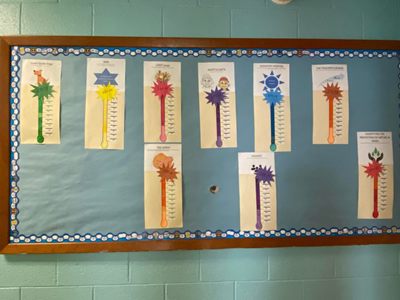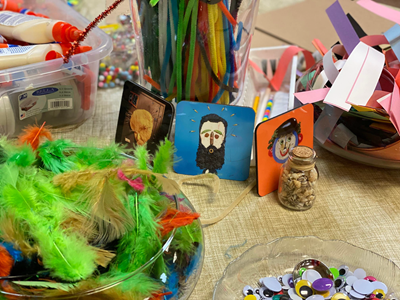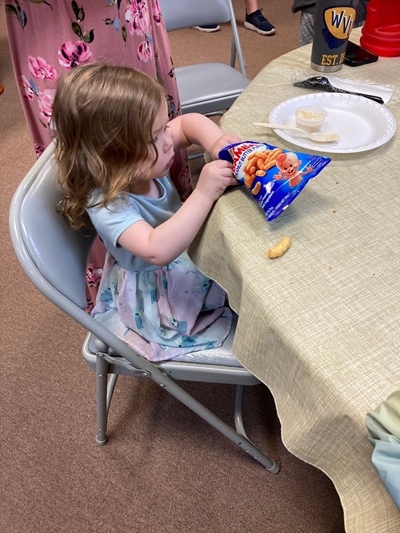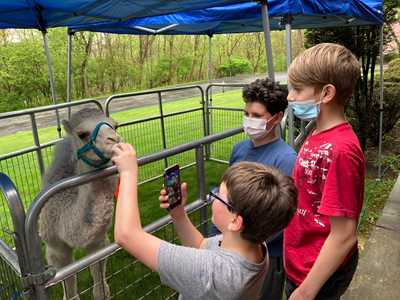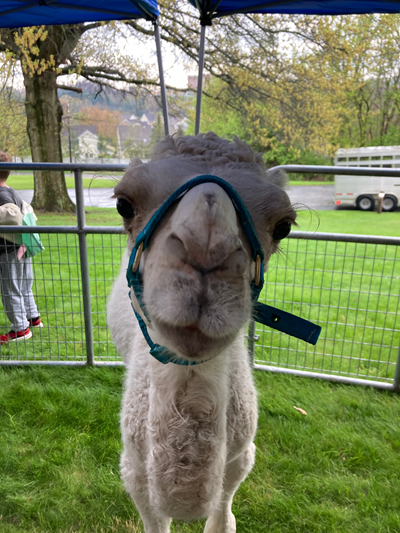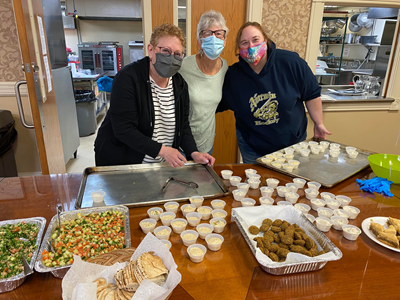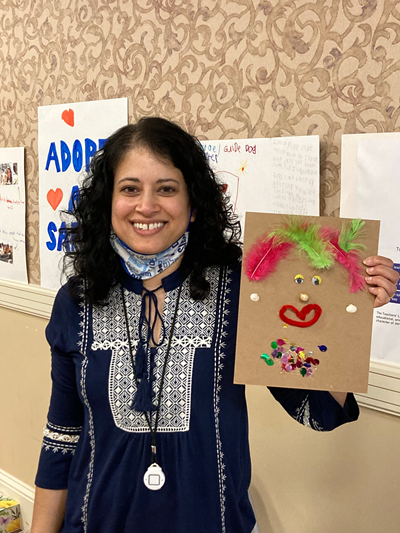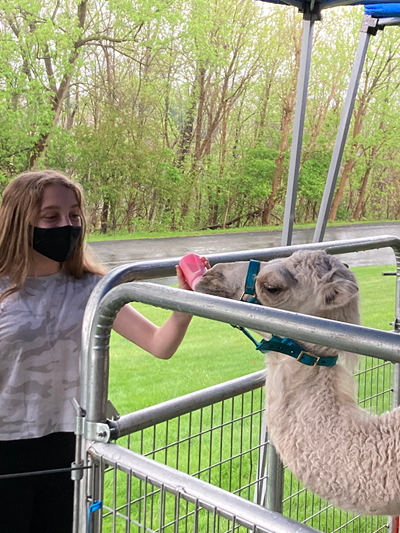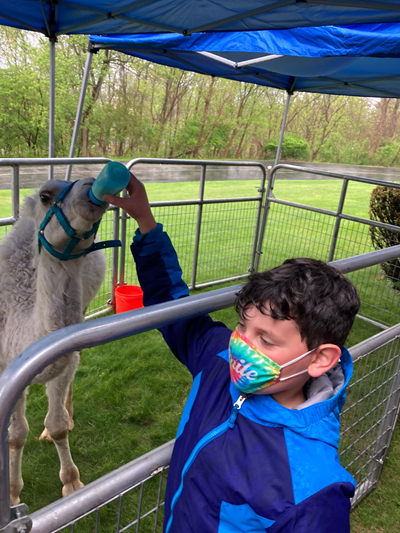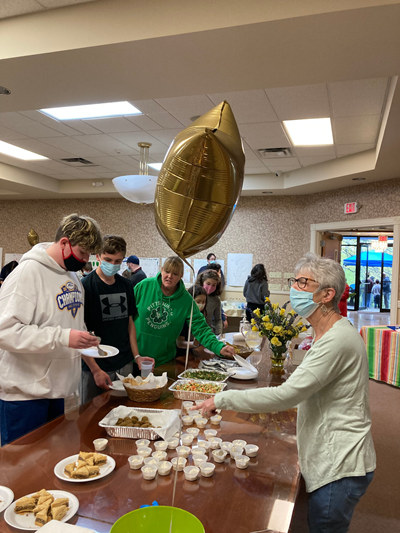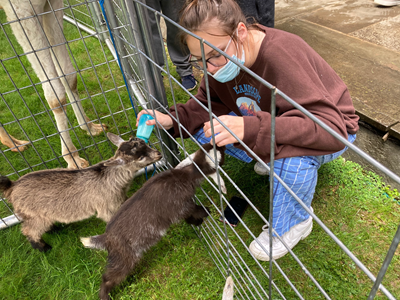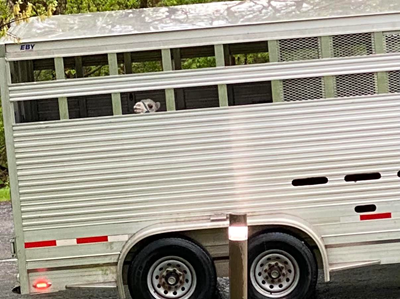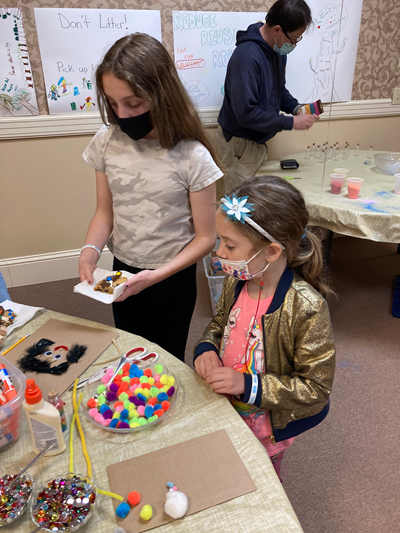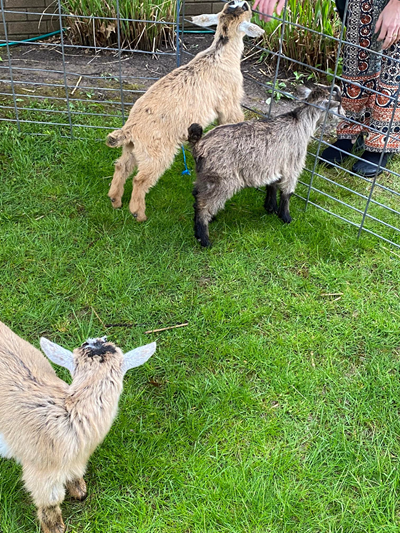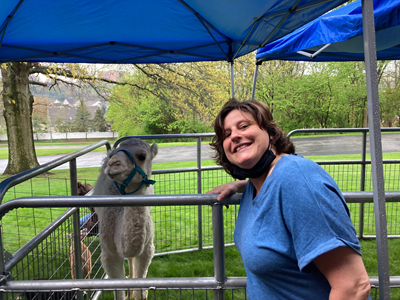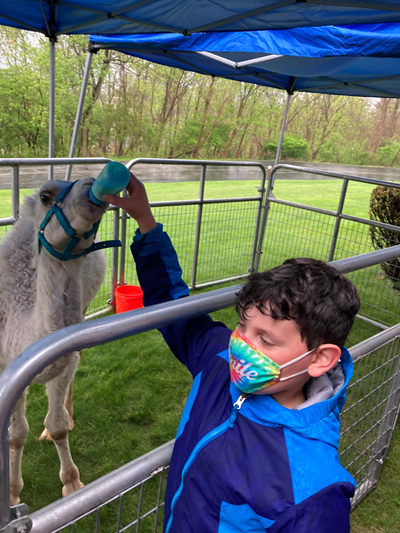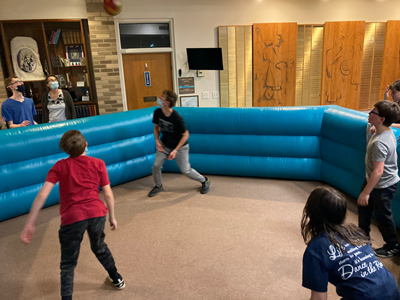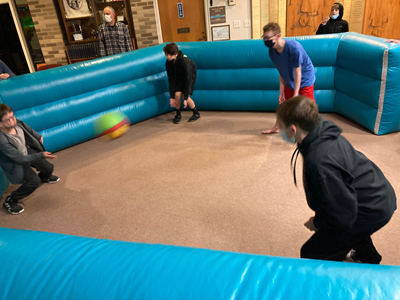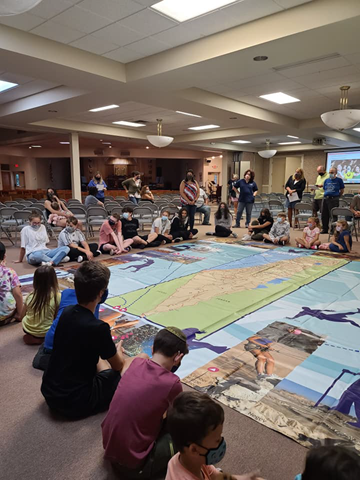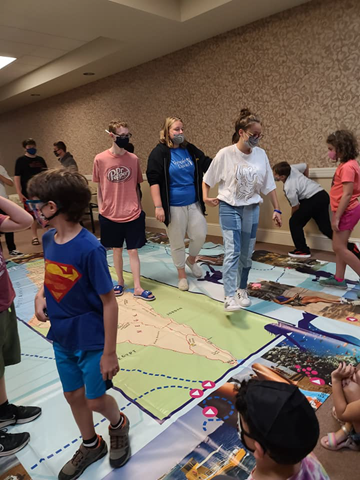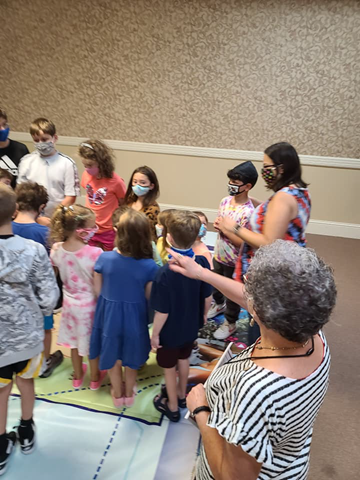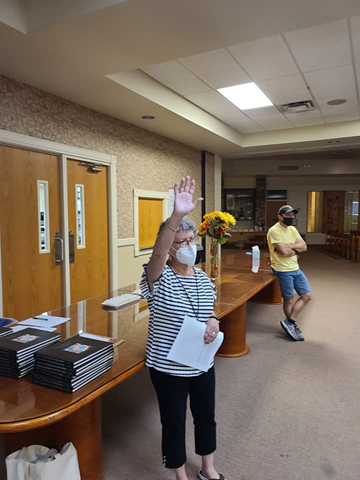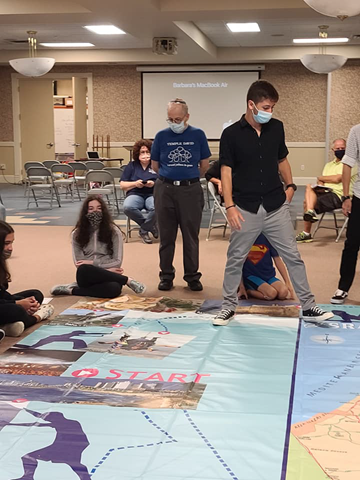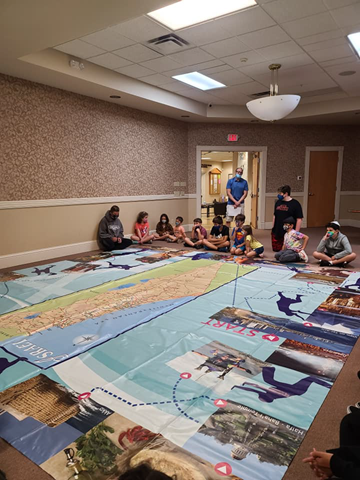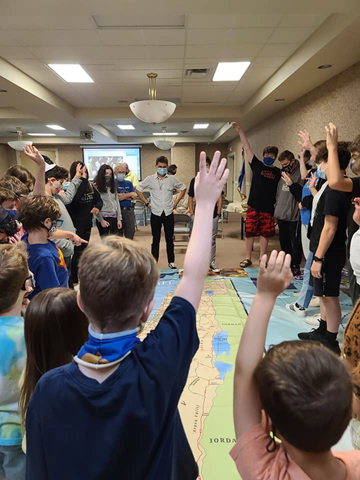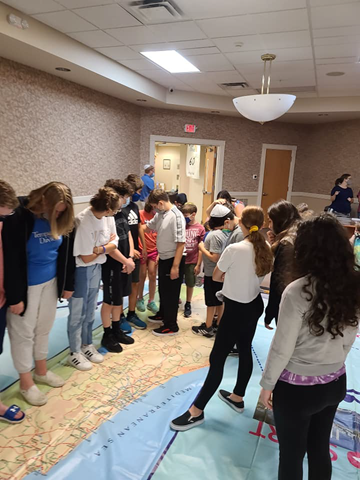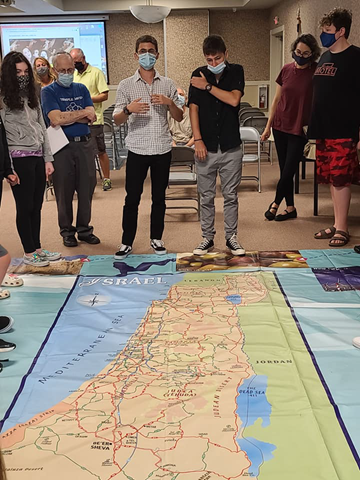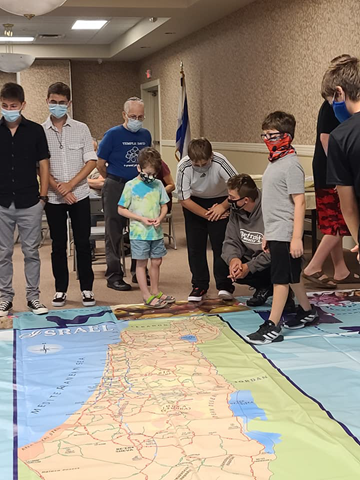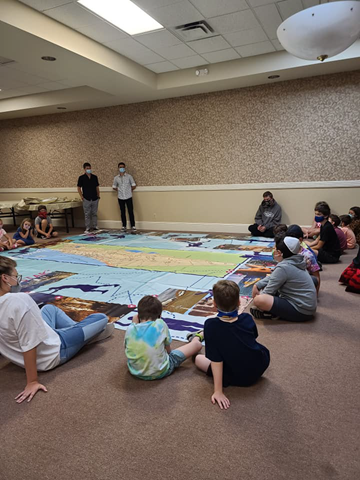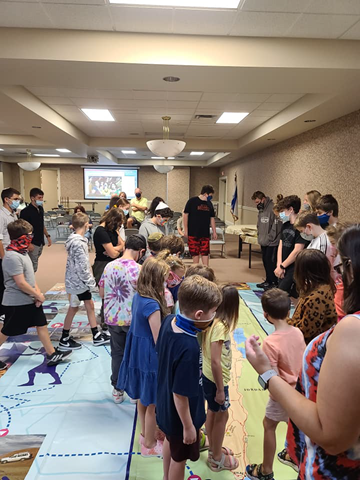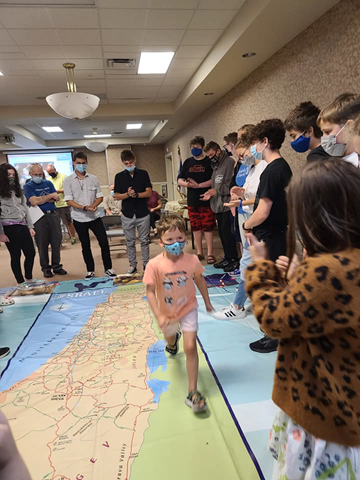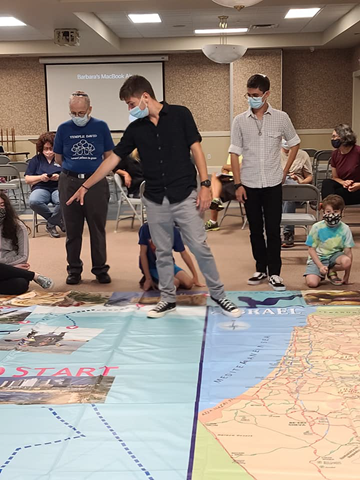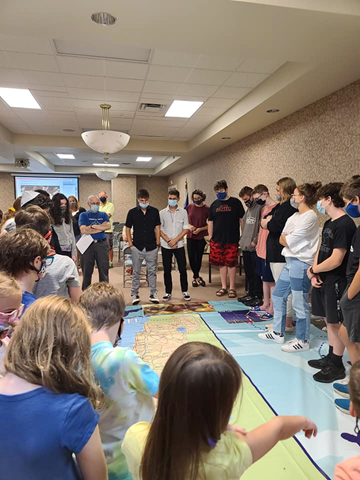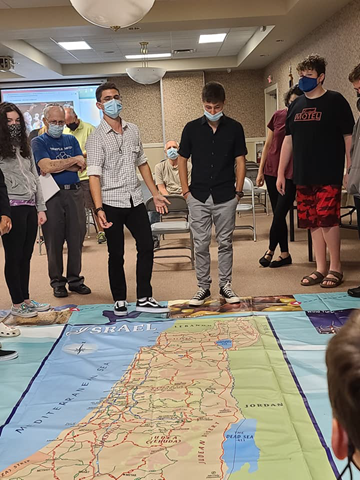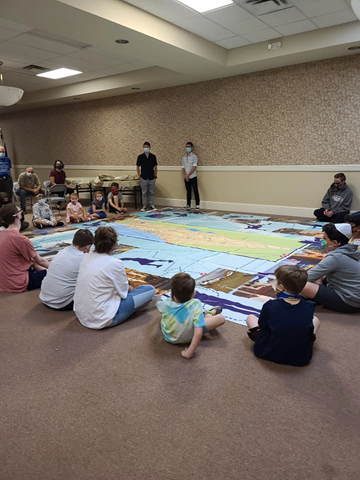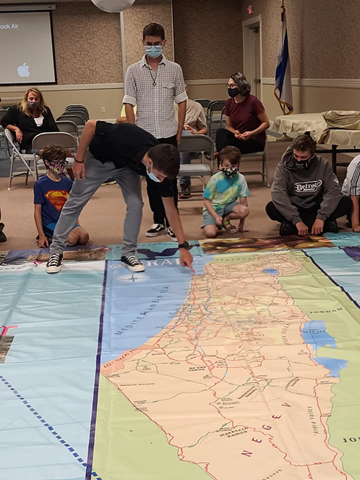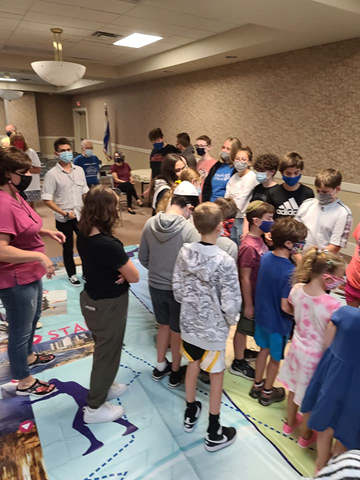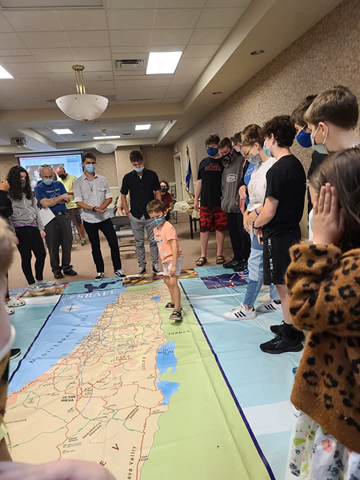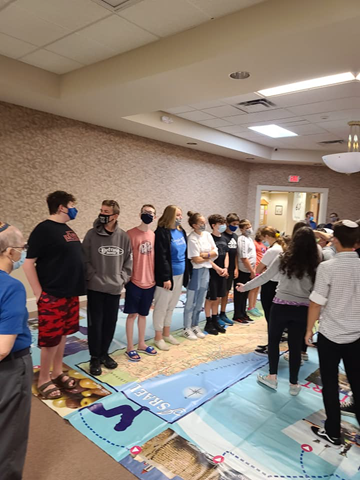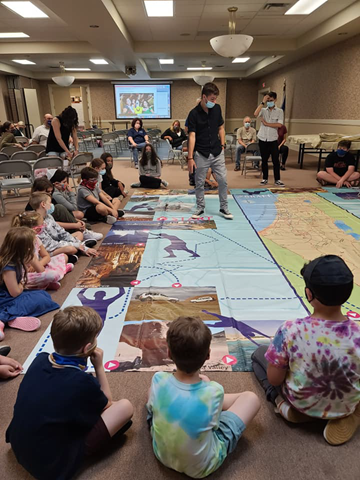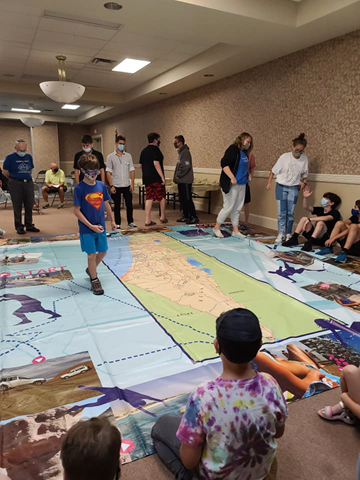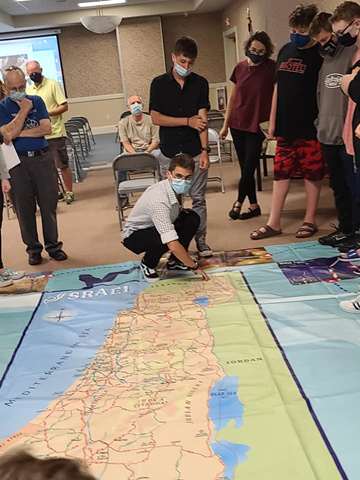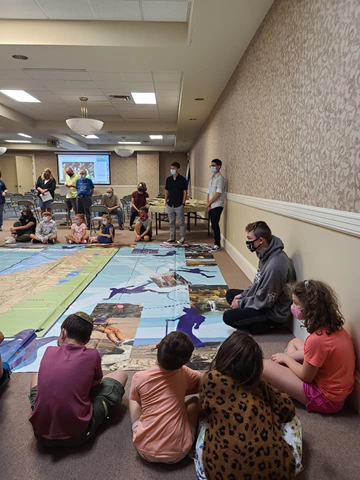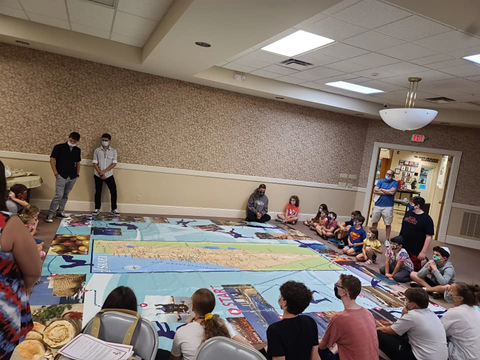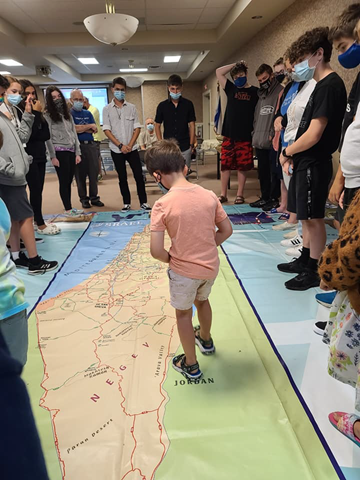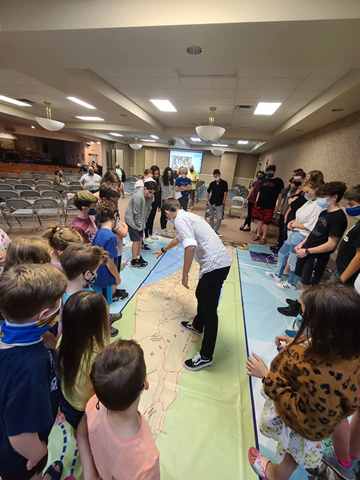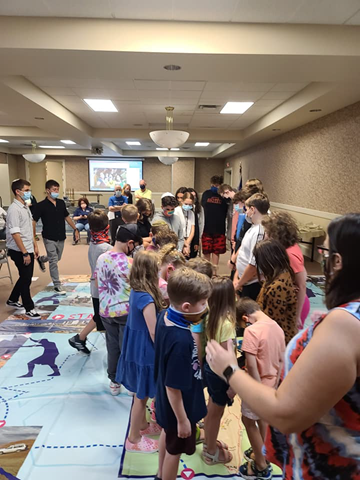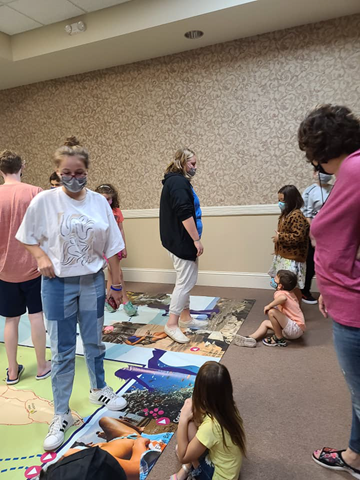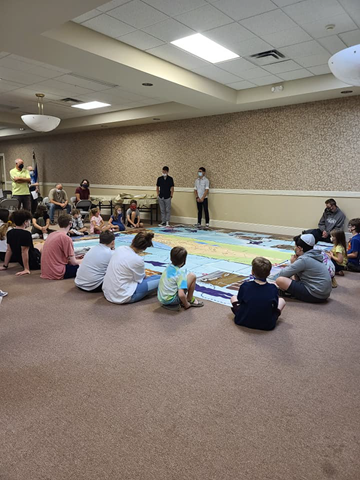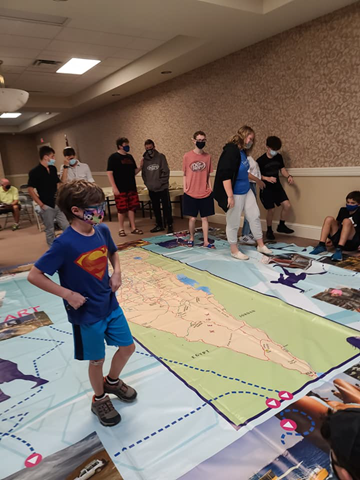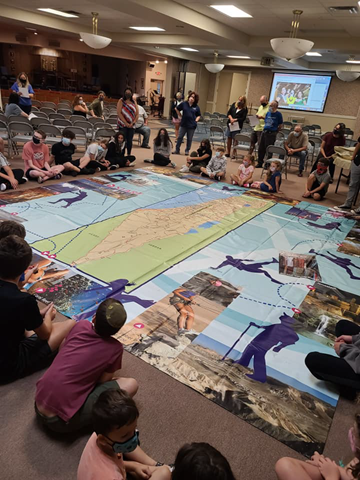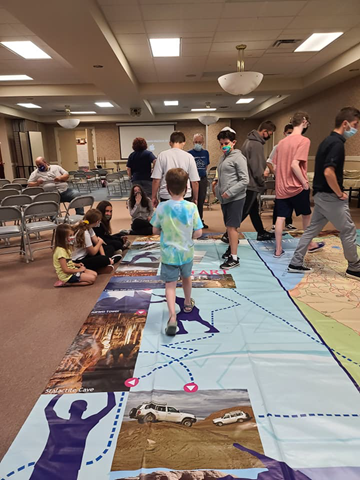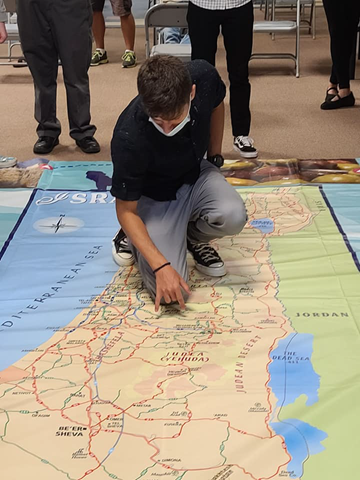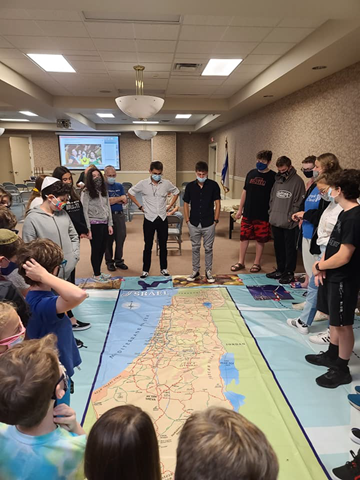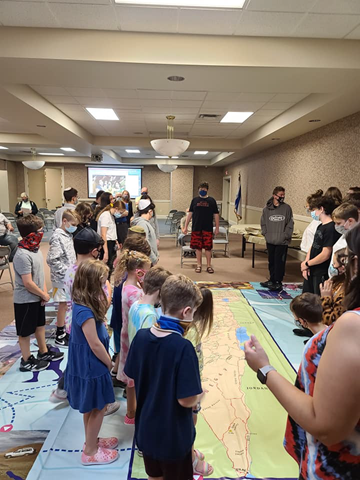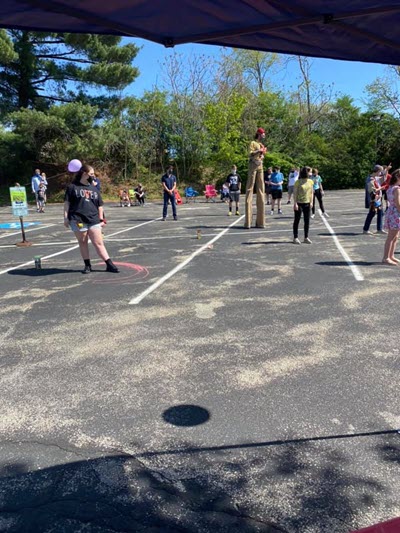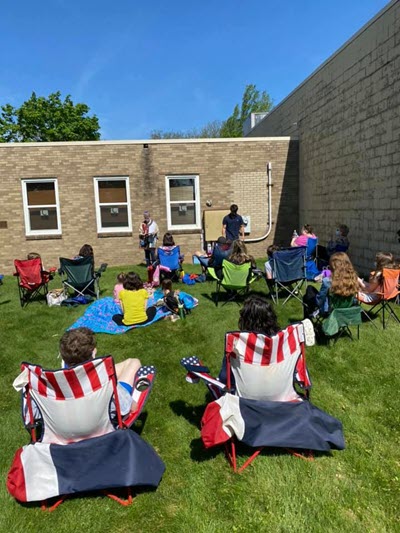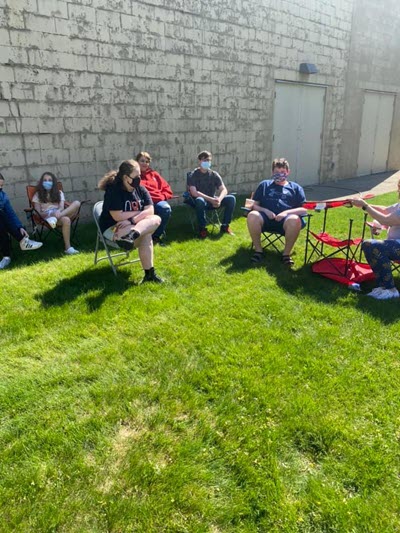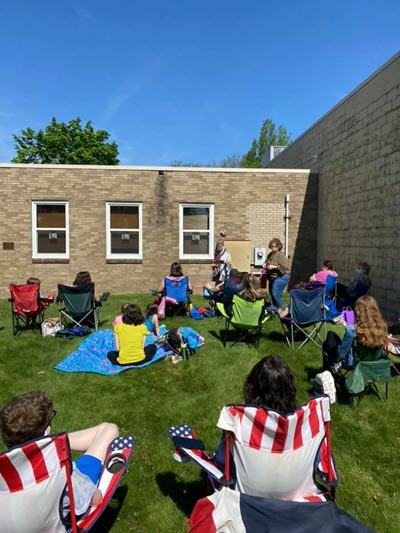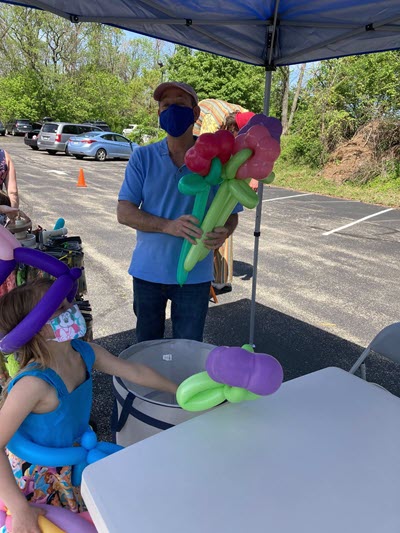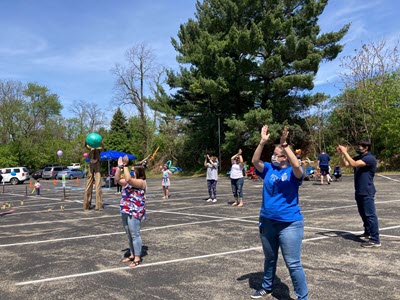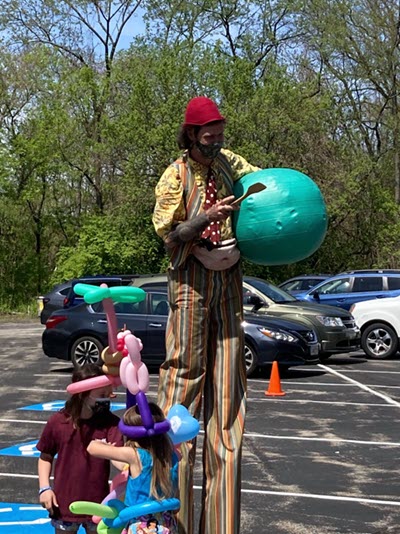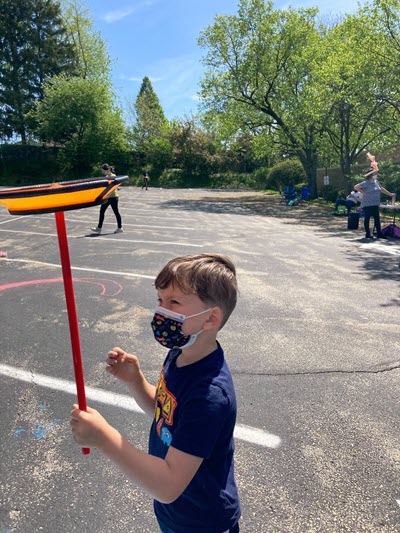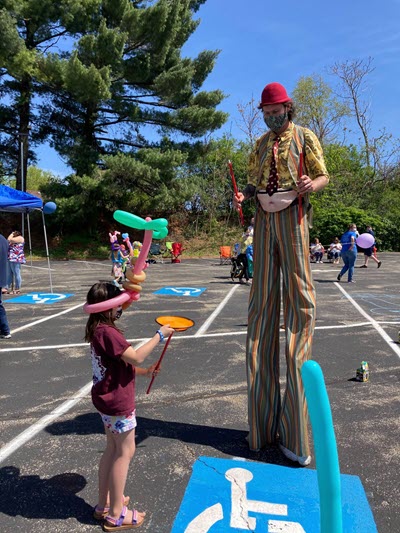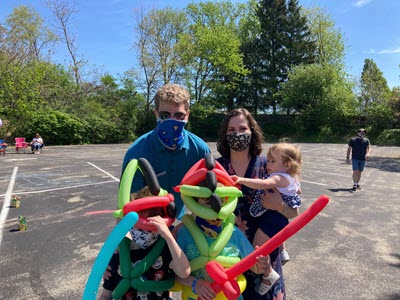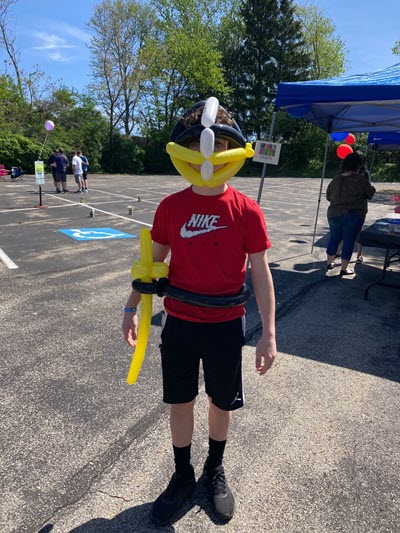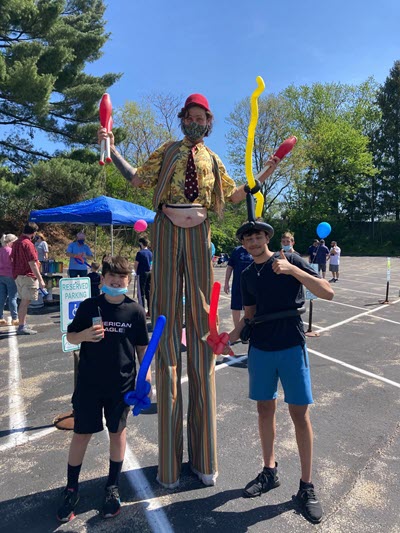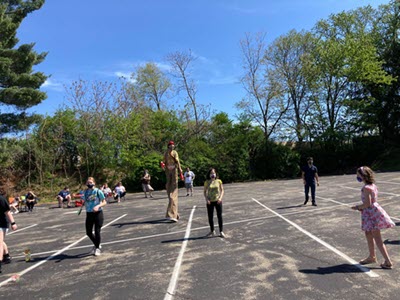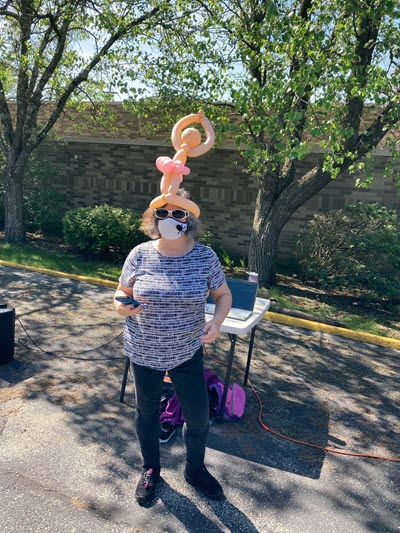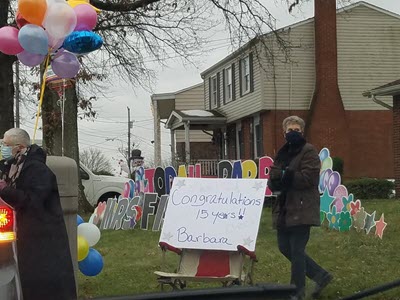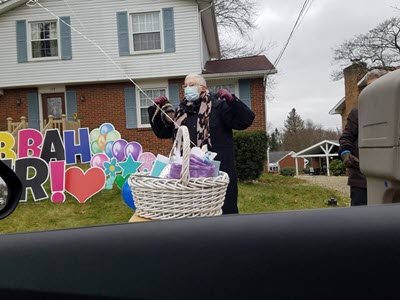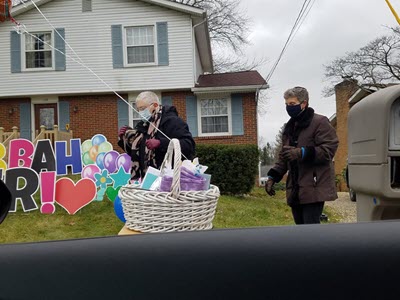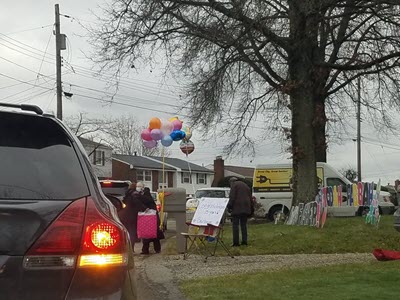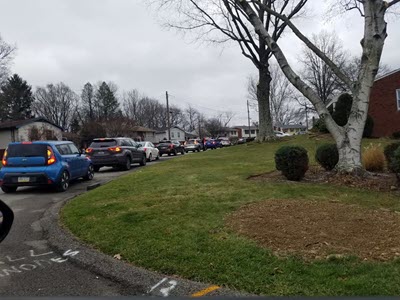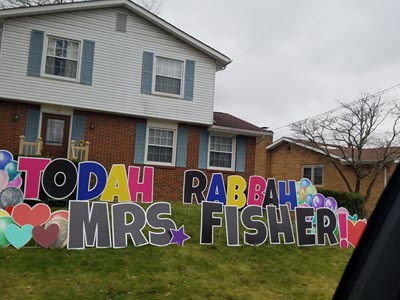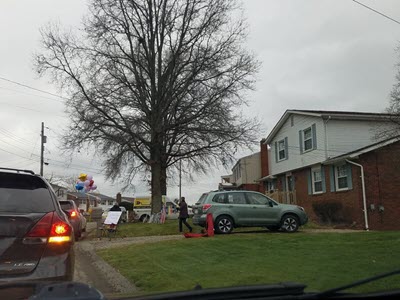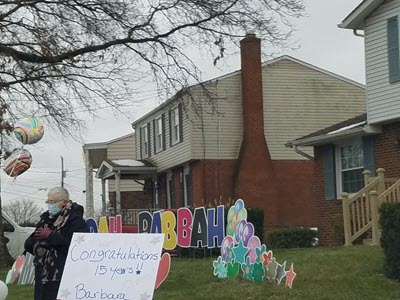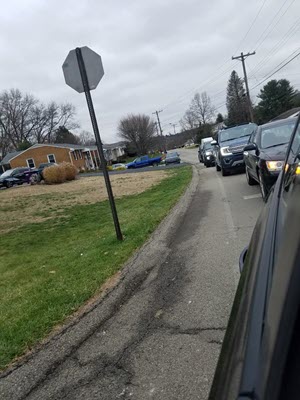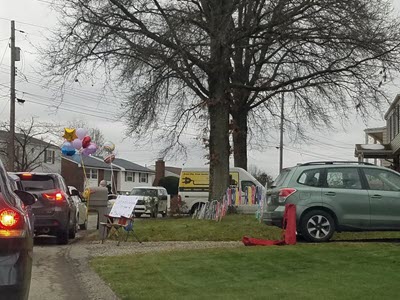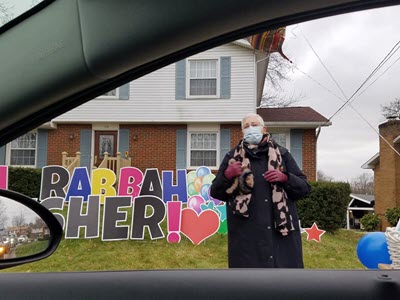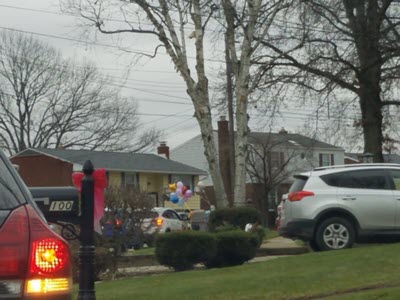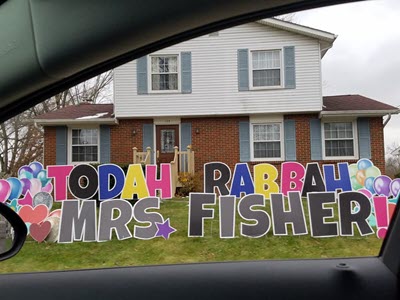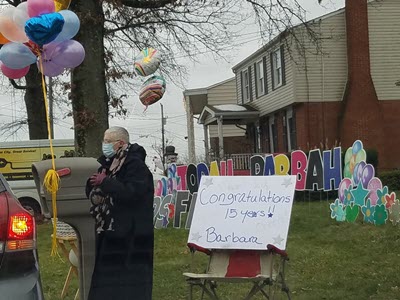
Rabbi Barbara AB Symons,
Director of Education
Published August 2022
2022-23: Focus on History
Here are the fundamental ideas for our year-long focus on History with an example of how we will bring it to life:
- An individual can shape the course of history.
- We will meet individuals from across history and recognize that we too can change the trajectory of history in our own families and beyond.
- Each of us is a link in the chain of tradition and with it comes a responsibility to learn from the past and actively influence the future.
- We will learn about our own families and the choices they made and the choices we can make.
- The Jewish presence in America has been a model of immigrant success despite discrimination.
- We will see how many of our ancestors came to this country very poor but through the value of education and other factors, became successful.
- American Jews have taken stands on both sides of every important issue in American history and been influential beyond our numbers.
- From labor unions to voting rights to members of congress and the Supreme Court, Jews have made our voices heard.
- History is nothing other than the story of our people.
- Our approach will be through stories and activities, not memorizing dates and facts.
- The Jewish people includes a diversity of cultures, languages, ethnicities, races, gender identities.
- We will learn a little Yiddish and Ladino, taste Jewish foods from around the world and celebrate Jewish diversity.
- “Never again” means that we have a responsibility to prevent genocide.
- Our students will recognize that because we have been victims at various times in history, we have a responsibility beyond ourselves.
- Anti-Semitism today still exists around the world and in our own community and we must actively fight it.
- Locally and globally, we cannot stay silent and will gain tools to respond.
- “It is a Mitzvah for Jews to survive as Jews.” – Emil Fackenheim
- For Jewish history to continue, we must engage in learning, worship and acts of loving kindness.
Published June 2022
Let Use Live Up to Our Name: Israel
Would that Jews of all ages experienced Israel as we did on our last day of religious school. We had a bit of time with our Shinshin Amit to say goodbye after he taught us so much. We had fun using our creativity in Hanoch Piven artistic style. We ate felafel and hummus, Bamba, and baklava. We did sand art and played GaGa. And, of course, we welcomed Smitty the two-month-old camel and seven one-month old goats. We had our final tzedakah collection for our nine Israeli organizations. There was joy and excitement, trying new experiences and enjoying familiar ones.
In a year in which every student learned about Israel and Temple as a whole offered book discussions and online cooking with Israeli chefs as well as now singing the prayer for Israel in Hebrew during services and planning our next trip, if congregants wanted to engage with Israel, we made it easy to do so.
Israel is multifaceted and complicated. It is old and new, a democracy that doesn’t separate synagogue and state, a difficult neighborhood with some calling for her destruction and new peace treaties simultaneously occurring.
As we tried to do with our students, let us do for ourselves: connect to Israel on her terms, not those of name callers that use false accusations like “apartheid” or “colonizers.” Let us connect with Israel not through splashy (and often negative) headlines but through reading articles in secular papers as well as the Times of Israel, ARZA, and Hadassah among others. Let us recognize that to be a Jew is to have a connection with Israel from the very first moment when God called to Abraham (and Sarah), “Take yourself from your land, from your birthplace, from your father’s house to a land that I will show you. I will make of you a great nation, And I will bless you; I will make your name great, and you shall be a blessing.” (Genesis 12)
Let us live up to our name Am Israel: A People of God-wrestlers who have a right to self-determination in our ancient homeland, the land of Israel.
Published May 2022
L’hitraot Israel (See You Later, Israel)
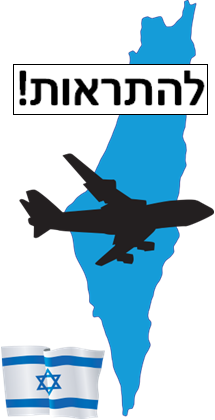
When you read this, our religious school year will be drawing to a close: a full year of full-on Israel studies with a big year-end everything Israel celebration (photos in next issue). Here is a taste of what we did just at our morning gatherings:
- We heard from Protestant, Catholic, Baha’i, and Muslim speakers about their religions’ connection to Israel
- We made Mizrachs and hung them on our eastern walls at home
- We had time with Amit, our 19-year-old shinshin
- We ate Bamba, Bissli, and Israeli chocolate
- We met Theodore Herzl
- We joined in Israeli dance
- We tried artwork Hanoch Piven-style
- We sang and studied HaTikvah
- We played Kadimah
- We wrote “Pay” on our Dreidels
- We studied the currency, media bias, and Jewish holidays in Israel
- We Zoomed with Micah Symons while he was in Jerusalem eating Bamba
- We were introduced to our Israeli tzedakah recipients by 9 families
Add to that bowling for our 9 Israeli organizations, meetings with Israeli teens, cooking with two Israeli chefs, book discussions, and so much more!
Our students engaged in in-depth classroom learning thanks to our dedicated and creative staff: Jessica Raithel (PreK-2nd), Gail Schmitt (3-4), Bruce Antonoff and Reena Goldberg (5-7), Rachael Farber (8-10) and our madrichot Sara Pechersky and Gladys Varga. We also say todah rabbah to Barbara Fisher with Adam Fisher’s help for all she did within the office and beyond, and to our Religious School Commission: Arin Keough, chair, Melissa Cooper, Janice DiCola, Carol Gordon, Jim Moritz, Miranda Nixon, Mindy Pechersky, Sharon Saltzman, and Andy Schmitt.
There is so much more to learn about and engage with Israel. The miracle, beauty, values, and challenges with Israel cannot be confined to one year and yet we are ready: Next year, history will repeat itself. We will begin our school-wide study of history by meeting up with Abraham and Sarah and continuing right up to the present.
Published April 2022
Make for Yourself a Teacher, Acquire for Yourself a Friend
How do you honor members of the Temple whose impact has lasted decades and will continue to last for decades more?
We did just that during our Morning Gathering–a time when the whole school and many parents come together each Sunday and sing Hatikvah, learn about Israel, and have juice and challah preceded by blessings.
As Gail and Bruce Antonoff were soon to move, the religious school wanted to honor them, as did other groups, given how long Bruce had taught in religious school and that he had served as its Vice President in the recent past.
I felt that the best way to honor Bruce’s impact on the school began with words–specifically the words of the Weiger School’s Mission and Objectives since he led that process with a specific committee, and guidance from George Syzmanski in 2013. They are words that stand for our values and inspire us to this day to aim ever higher and deeper. They are:
Mission Statement
The Mission of the Weiger Religious School at Temple David, as a pulse of our congregation, is to develop proud, practicing Jewish adults who have the skills and responsibilities needed to transmit their knowledge and faith to future generations; who understand Jewish values, Jewish languages, Torah, the struggles and triumphs of Jewish history, and the Covenant with God; who are passionate about engaging in prayer, study and acts of loving kindness; and who are well- prepared to function as Jews in a predominantly non-Jewish suburban environment.
We will accomplish this by providing teachers who are committed, knowledgeable, energetic, and lead by example and persuasion; utilizing a sound Reform curriculum that includes text-centered and experiential learning, field trips, history and current events; involving families in the education of their children; encouraging family attendance at and participation in Shabbat, high holydays, and festival services; providing programs that support the purposes of the Religious School including Youth Group; and providing financial support for staff, facilities, curriculum and materials, all in an authentic and respectful environment supported by the entire congregation.
Objectives
- All students will have the knowledge and skills to proudly practice their Jewish faith.
- Every child will behave in a manner that exemplifies Jewish values.
- Every child will display a love of learning about Judaism.
- Every child will explore his/her relationship with God.
After sharing the words of the Mission Statement and Objectives, I invited students, parents, and faculty to share their own words and they were terrifically powerful.
As the students left the social hall, the Antonoffs’ friends were waiting to greet them.
The Mishnah teaches, “Make for yourself a teacher, acquire for yourself a friend.” Bruce and Gail Antonoff have done both and we wish them well.
Published March 2022
Teaching Through Verbs
At a recent faculty meeting, we studied this portion of A Statement of Principles of Reform Judaism which was adopted in Pittsburgh 1999:
We are committed to Medinat Yisrael, the State of Israel, and rejoice in its accomplishments. We affirm the unique qualities of living in Eretz Yisrael, the land of Israel, and encourage aliyah, immigration to Israel.
We are committed to a vision of the State of Israel that promotes full civil, human, and religious rights for all its inhabitants and that strives for a lasting peace between Israel and its neighbors.
We are committed to promoting and strengthening Progressive Judaism in Israel, which will enrich the spiritual life of the Jewish state and its people.
We affirm that both Israeli and Diaspora Jewry should remain vibrant and interdependent communities. As we urge Jews who reside outside Israel to learn Hebrew as a living language and to make periodic visits to Israel in order to study and to deepen their relationship to the Land and its people, so do we affirm that Israeli Jews have much to learn from the religious life of Diaspora Jewish communities.
Taking the lead from this document, we shared how we can bring these verbs of Israeli engagement back into our classrooms. How will we affirm, encourage, rejoice, help our students commit, and should we even urge? As usual, our teachers had great ideas including encouraging through touching on things in Israel that are relatable such as sports and food, rejoicing that we have a homeland–and affirming a connection to this country unlike any other country we may visit.
Published February 2022
A Different Kind of Sunday: Conference Day!
Conference Day is one of my favorite days of the year. We started having mid-year conferences a few years ago instead of report cards in order to strengthen relationships between teachers and parents and to further engage our students in their own learning.
In Gail Schmitt’s (unsolicited) words, “I loved the conferences. Each of my parents came, and they went very well! Everybody seemed positive, and the kids did a good job sharing their work with their parents.”
By inviting students, parents, and teachers to meet in person we demonstrate that in the Weiger School, learning is never limited to a certain age group or to the confines of the classroom. This year, with many thanks to Barbara Fisher for overseeing logistics and adding creativity, and to Carol Gordon for assisting given that I was in my own conferences, this is what students and parents did before and after their conferences:
- Taste test between Israeli snack foods Bissli and Bamba-with form to fill out. (Bamba won. As expected.)
- Perusing Israeli books and distributing this article for all families to read:
https://blogs.timesofisrael.com/the-hypocrisy-of-expecting-perfection-from-israel/ - Mitzvah Shleppers and Counters: for Ronald MacDonald House Personal Care bags in preparation for Mitzvah Day
- Card decorating for the Personal Care bags
- Tzedakah opportunity focused on our nine Israeli organizations
Published January 2022
We Are More Than Our Mission Statement
The Weiger School is more than its Mission Statement and Objectives, which are:
Mission Statement
The Mission of the Weiger Religious School at Temple David, as a pulse of our congregation, is to develop proud, practicing Jewish adults who have the skills and responsibilities needed to transmit their knowledge and faith to future generations; who understand Jewish values, Jewish languages, Torah, the struggles and triumphs of Jewish history, and the Covenant with God; who are passionate about engaging in prayer, study and acts of loving kindness; and who are well- prepared to function as Jews in a predominantly non-Jewish suburban environment.
We will accomplish this by providing teachers who are committed, knowledgeable, energetic, and lead by example and persuasion; utilizing a sound Reform curriculum that includes text-centered and experiential learning, field trips, history and current events; involving families in the education of their children; encouraging family attendance at and participation in Shabbat, high holydays, and festival services; providing programs that support the purposes of the Religious School including Youth Group; and providing financial support for staff, facilities, curriculum and materials, all in an authentic and respectful environment supported by the entire congregation.
Objectives
- All students will have the knowledge and skills to proudly practice their Jewish faith.
- Every child will behave in a manner that exemplifies Jewish values.
- Every child will display a love of learning about Judaism.
- Every child will explore his/her relationship with God.
The Weiger School is more than its Mission Statement and Objectives. It is the warm and fuzzy stuff between the words, as important to our Jewish future as these words are. The Weiger School is a community which is why it was so important for us to be back together in person this year. It invites friendships. It is a place where we are in the majority – Jews of all ages, free to study and question. It is surrounded and supported by the Temple community. The walls and halls and decorations and programs are a celebration of Jewish culture, tradition and innovation, which is why it was Sneaker Day when we played Kadimah, why Mrs. Fisher goes out of her way to decorate for every holiday, why congregants bake challah for our morning blessings, and why our tzedakah is supporting Israeli organizations as recorded on our 9 donation thermometers. It is a place from which we reach out when a child or teacher experiences illness, sorrow or joy, to send good wishes, meals or support.
Ultimately, the Weiger School is a microcosm of our corner of the American Jewish world, and it is THE place to be on Sunday mornings and Wednesday afternoons.
Published December 2021
Bringing Israeli Culture to the Weiger School
The goal for this year is to experience Israel from Monroeville in as multi-faceted an approach as possible. One of those ways in which we engaged is through the art of Hanoch Piven (www.pivenworld.com). After learning about him and about his process for creating art from everyday articles and activating our creativity, we had a lot of fun! Students created portraits first of George Washington and then of Israel’s first Prime Minister, David Ben Gurion. The funniest moment was when some students simply lifted George Washington’s hair into David Ben Gurion’s unique hairstyle, if we can call it that.
We also are comparing HaTikvah, Israel’s national anthem and the Star-Spangled Banner. Musically, do you think one or the other is a better national anthem? What about the words? What if you were an Arab Israeli citizen of Israel, then how would you feel?
On deck, we have: interviewing Theodore Herzl, creating a shuk (market) using Israeli currency, and so much more!
Published November 2021
Twenty Minutes and Counting
This year we have changed the format of our religious school day. On Sundays, we begin with a 20-minute school-wide gathering, including parents. Twenty minutes may not seem like a long time. We know that we can fill twenty minutes easily and without much preparation. But not this year.
This year, we come together for an age-appropriate Israel-focused story, activity, or topic. We have looked at the symbolism of the red, white, and blue of the American flag and then did the same with the Israeli flag followed by looking at artistic versions of the Israeli flag. It is based on the tallit.
We have listened to a story that took place in B’nei Brak, just east of Tel Aviv, by first learning about the city, its inhabitants, and the best place to buy challah–which is open all night on Thursdays.
On Sukkot, we looked at images of a man inspecting his lulav with an eyepiece before making a purchase, and a tall sukkah, a double-decker sukkah, a sukkah on a boat, and yes, a sukkah on a camel.
We have learned how Jews in America face East toward Jerusalem while praying or shaking the lulav, but Jews in Japan face West, and then we each made a Mizrach, an artistic piece saying “East” which hangs on our Eastern walls at home.
Each week, we top it off with singing HaTikvah and saying our blessings over grape juice and challah.
There is a lot we can do together in twenty minutes, and you are invited to join us from 9-9:20 a.m.
Published October 2021
First Day of School!
If you were at the first day of the Weiger Religious School (Sept. 12), this is what you would have seen:
- Students, faculty, and parents together in person!
- Welcoming new students and their families!
- Introducing a year of school-wide focus on Israel!
- Welcoming our new Shinshinim Ittai and Amit and doing a special activity with them!
- Learning about Rosh HaShanah in Israel through the evolution of greeting cards, the latest being a YouTube video! (See https://tinyurl.com/yhskpsq2.)
- Bulletin boards ready to celebrate Hebrew achievement and to inform about the 9 Israeli organizations we will be supporting throughout the year!
- Bamba Israeli snacks to welcome the year!
- And most importantly: a celebration of a new year TOGETHER!
Photos: Nikke Williams
Published September 2021
No Text Books, Text People
This year, as we enter into our Israel-focused curriculum, our faculty will strive to teach based on these fundamental ideas:
- Having a connection to Israel strengthens one’s Jewish identity.
- In order to be part of Am Yisrael (The People Israel), one must understand Eretz Yisrael (The Land of Israel) and Medinat Yisrael (The [modern] State of Israel).
- Studying Israel is an emotional, intellectual, and creative pursuit.
- The Jewish people’s connection to the land of Israel began with Abraham in 1800 BCE and has been continuous.
- Jewish texts solidify our on-going and deep connection to the land of Israel.
- American Jews have a home in America and another in Israel.
- Visiting Israel will deepen a student’s Jewish identity.
- Being lovingly critical of Israel is the sign of an authentic relationship.
- An individual can change the course of history.
- Jewish holidays are the way we re-experience the history of the Jewish people.
- When major events that affect the Jewish people occur we mark them with the creation of new observances and rituals.
It is a daunting challenge to teach Israel and “get it right”–which means not to slide into geography and chronology and also not to teach “falafel” Israel, but to approach Israel with love, depth, creativity, and honesty. To that end, our teachers are our primary resource.
As Rabbi Abraham Joshua Heschel said, “What we need more than anything else is not textbooks but text people.” How true that is. This year, though we have good textbooks, they will be the last resort for our teachers as they explore both ancient and modern Israel through the arts, culture, media, sacred texts, and news sources.
Thank you to our teachers Jessica Raithel (Pre-K thru 2), Gail Schmitt (3-4), Bruce Antonoff (5-7), and Rachael Farber (8-10), and to our Administrative Assistant Barbara Fisher for accompanying our students on this year-long journey into the Promised Land.
Published August 2021
Zooming-in towards In-Person Learning
As we prepare to come back to school in person in the Fall, I have been meeting online with every religious school family and asking these questions:
- What is your overall goal in bringing your child(ren) to the Weiger Religious School as their formal Jewish education?
- How has/hasn’t the Weiger School met your expectations?
- How would you like to be involved in school next year?
- Next year’s curriculum is focused on Israel; what do you desire for your child(ren) to learn and/or experience?
- What do you want to learn about Israel?
- What do I as the Director of Education need to hear from you?
Though I did not share the questions in advance of our meeting, I explained that this short conversation was meant to open the door to further communication. After all, religious school parents, students, and staff are partners not only in curricula but in the ultimate goal, as voiced in our mission statement: To create proud, practicing Jewish adults.
Published June 2021
The Ingredients of Joy
The goal was to end the year in joy. And so we did! Here are some highlights from our first school-wide day in person which was also our last day:
- Because we were at home all year, the end-of-year teacher gift was a beautifully framed house blessing; with the exception of Jacob Brand, our madrich, who received a gift card to Kohl’s so he can finally be off to school in style! (Though we were so thankful to have him for another year.)
- The students who met the service attendance and religious school attendance requirement were honored.
- The students who passed the most ramot were given a giant-sized Israeli chocolate bar.
- Commission members worked hard to ensure all ran smoothly.
- Mike the Balloon Guy made every imaginable balloon animal and item for our students
- The juggler on stilts joined in Israeli dancing led by Lynn Berman
- There was sand art and chalk mosaics.
- As we transition to next year’s focus on Israel, the Israeli snacks: Bamba, Pesek Z’man chocolate , and halvah had to be ordered in Hebrew by all hungry snackers
- And most importantly, there was joy.
Published May 2021
At Last, In Person
Ironically, the final day of religious school will be the only school-wide in-person day all year. We will come together for a closing ceremony including honoring our faculty: Jessica Raithel, Rabbi Stephanie Wolfe, Pati Eisenberg, Bruce Antonoff, Rachael Farber, and Jacob Brand (madrich), our Administrative Assistant Barbara Fisher, and Confirmation students Rebecca Gerse, Joshua Goldberg, and Elijah Sloan, though we will not be celebrating quite yet. We will honor the members of Commission: Melissa Cooper (chair), Arin Keough (Liaison), Rachael Farber, Carol Gordon, Jim Moritz, Mindy Pechersky, Sharon Saltzman, and Andy Schmitt. We will celebrate those students with perfect attendance, those who completed their service requirement, and those who passed the most ramot (Hebrew levels).
And we will celebrate because not only do the students, faculty, and parents deserve it, we all need it. We will have Israeli dancing and Israeli crafts as we get ready for next year’s school-wide focus on Israel. We will have a juggler and balloon-animal maker. We will decorate parking lot mosaics and, of course, have plenty of Israeli snacks.
We will end on a joyful note. And then, without missing a beat, we will continue to develop the Israel curriculum and work toward in-person learning in the Fall.
Published April 2021
Religious School: Looking Back and Ahead
Here are a few glimpses into recent weeks:
For Purim, Stefanie Resnick of Studio Playground (and our cousin!) taught students some theater techniques which she then helped us apply to the Purim Story. If your child or grandchild wishes to register for her online classes, here is the link: www.studioplaygroundtheatre.com/classes
The 8-10th graders participated in three multi-part sessions with the Religious Action Center, the latest of which provided students with learning more about Racial Justice, Immigration, Mental Health, and Reproductive Rights, and then giving them tools for advocacy. The majority of our students chose Mental Health, which is an important and interesting fact in itself, and here is some of their feedback: “I thought it was good to think about how mental health is super important.” Also, interesting facts they shared in the Zoom and some of the other things they talked about. “Mental health should not be taken like it is a joke and is particularly important to life and to keep you happy.” Another student wrote, “I realized how important it is for kids my age to have mental health resources in our schools. I didn’t realize how many students need this type of help.” A third voice, “I thought it was cool how the Michigan State [sic] had a program for it. I think schools need that. And a person in my break room went to a school that had mandatory check-ins and I think that sounded really helpful too.”
Bruce Antonoff’s 5-7th grade class led a meaningful Shabbat service during which the students led many of the prayers and also shared their Hebrew names and for whom they are named.
Upcoming events include:
- The outdoor Havdalah service led by Jessica Raithel’s Pre-K thru 2nd Grade class.
- Rabbi Stephanie Wolfe’s 3rd and 4th grade Shabbat morning class service.
- A visit to the Keeping Tabs Holocaust Memorial in Squirrel Hill for the 8-10th graders.
- Special Passover programs
- Plans for the end of the year gathering!
Published February 2021
A Prayer for Teachers
During the Weiger School’s Morning Gathering on Sunday, January 10, Bruce Antonoff shared that it was exactly 50 years before that he had begun to teach religious school at Temple David. Though noting that not all years were contiguous at Temple David, he looked around the screen and saw not only his current students and his current madrich, Jacob Brand, a former student, but also the students of his students–including Rabbi Stephanie Wolfe. Yasher Koach, Bruce!
In celebration, I read the creative version of Kaddish D’Rabanan, a form of the Kaddish said by adult students in honor of their parents and teachers. During our Shabbat morning worship, this prayer has gained meaning each week because each week I invite someone new to share a bit about a special teacher, mentor, or coach which honors that person and further connects us to the student.
The words are:
For our teachers and their students,
And the students of the students,
We ask for peace and lovingkindness,
And let us say, Amen.
And for those who study Torah
Here and everywhere,
May they be blessed with all they need,
And let us say, Amen.
We ask for peace and lovingkindness
And let us say, Amen.
(Mishkan T’filah, p. 209)
May we have reason to pray them often.
Published January 2021
15: A Number to Celebrate
When writing Hebrew numbers, one cannot write “15” in the regular way. 14 is yud (10), dalet (4) but 15 cannot be yud (10) hay (5) because that is part of God’s name and so it becomes tet (9) vav (6), still equaling 15. All this is to say: 15 is a unique number.
15 years after Barbara Fisher began in her position as Administrative Assistant to the Weiger Religious School (though her title was “Secretary” at the time), it was time to celebrate her contributions. She is the Weiger School’s cheerleader, the one who keeps all the files in order while decorating bulletin boards and taking photos (in a regular year). Barbara creates colorful, engaging fliers, keeps records, sends e-mails and texts to parents, and is the most joyous when one of our students passes their ramah (Hebrew level). She assists the faculty and madrichim, the Director of the Religious School, Chairperson Melissa Cooper and the other members of Commission, and coordinates with Beverly, Temple committees, and JESP. We thank her for all that she does for the Weiger School, which means for all that she does for all of us.
Our drive-by celebration included many cars with waves and decorations, cards and honking as Barbara stood in front of her house and in front of a yard sign on her front lawn:
15 is a unique number, especially when we pause to celebrate it. Thank you to Barbara Fisher for all that you do for the Weiger Religious School.
Published December 2020
What’s In a Name?
As our study of the Lifecycle continues, we are engaged in a lot of discussions about our Hebrew names.
There are differing traditions in choosing Hebrew names. Most often, Sephardi Jews name for living relatives and Ashkenazi for deceased relatives who have lived long lives. We name using either the first letter of the relative’s name or the meaning of the name. The most powerful part of the naming ceremony for me is when the parents, or in the case of someone converting he/she him/herself, explains how the name was chosen and what traits of the loved one they wish to see emulated.
When do we use our Hebrew names? During lifecycles and in-between: when you are called to the Torah first as a Bar/Bat Mitzvah and then any time in the future, when you sign the ketubah at your wedding, when in need of Mi Shebeirach (the prayer for healing) and in the prayer El Malei Rachamim (God Full of Compassion) said at a funeral and unveiling. Our Hebrew names travel with us throughout life.
And there is another layer: when one is called by their Hebrew name, the names of their parents are used as well. In my case, for example: HaRav (Rabbi) Bracha bat (daughter of) Reuven (my father) and Yonina (my mother). That means I bring with me to the bimah or as I sign the ketubah not only my parents but the relatives for whom they were named. In other words, at least four generations of my family would ascend the bimah with me or sign the ketubah with me.
Some students don’t have a Hebrew name so I am now fully engaged with multiple families to plan naming celebrations. If you don’t have a Hebrew name–regardless of your age!–I would relish working with you to choose a Hebrew one.
A name reveals your ancestry and when it is used signals your connection to Judaism. What’s in a Hebrew name? You are.
Published November 2020
Religious School:
East, West, North, South, and Monroeville
I brought the idea to the Weiger School Commission and the Commission said “Yes” and then we brought it to our oldest students. Picture this: 150 teens from all over the United States joining together on Zoom in order to learn about and work toward Civic Engagement and more through the Union for Reform Judaism’s Religious Action Center’s program. So far they’ve:
- Seen their peers from across the country
- Learned the difference between social action (i.e., donating food) and social justice (i.e., advocacy aiming to reduce homelessness, a preexisting condition for hunger)
- Rooted the basis for advocacy in Biblical and Talmudic texts
- Responded to quotes from the late Congressman John Lewis and the late Supreme Court Justice Ruth Bader Ginsburg about the need to recognize that “democracy is not a state but an act.”
- Committed to helping others make a plan to vote
This was all in 1-1/4 hours on a Sunday afternoon…and that was only the first session. In a total of 9 sessions, they will engage with racial equity, diversity and inclusion and gain tools for action and advocacy.
If you wish to learn more, go here: https://is.gd/tdrac202011—and know that there are plenty of programs for adults as well. Just scroll through www.rac.org
Published October 2020
Religious School 5781: Linking Up
Religious School started on Sunday, September 13. No faculty members or students entered the building. The classrooms remained empty not only of students but of materials and decorations that welcome a new year. The bulletin boards are what they were as last year ended. There was no challah and juice. The parking lot remained empty. But that’s not to say that we did not connect with one another.
Our 9 a.m. gathering via Zoom featured a “welcome back” to all and a special “welcome” to our newest student Minda Raithel (K) and a “welcome back” to Dominick Bedo (7). With thanks given to the faculty: Jessica Raithel, Pati Eisenberg, Bruce Antonoff, and Rachael Farber for investing in Zoom training this summer and a welcome back to Jacob Brand as a madrich as well as our annual “thank you” to Barbara Fisher for all of her behind the scenes work, we were off and running!
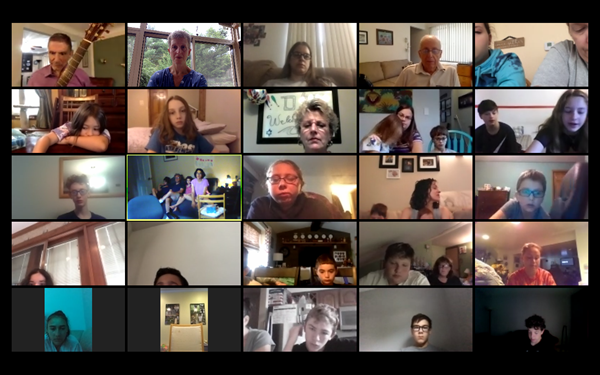
Since the entire school is focused on life cycles (you can see our curriculum on our website), we began with Tom Congedo teaching the words and tune for Siman Tov.
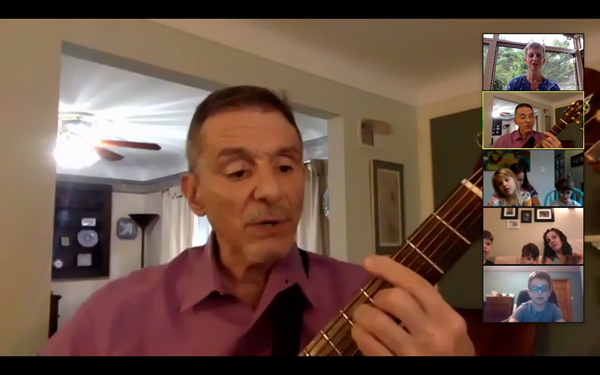
The joyousness led into a slideshow of various life cycle-related photos, asking which they could identify. The slide show included: a k’riah ribbon, a chuppah, a baby naming certificate, a tallit, a kittel, and more. The next step was to hear brief testimonies of meaningful life cycles from Natalie Keough (our most recent bat mitzvah), Reena Goldberg (wedding), Lisa Carney (funeral), Helen Dorra (conversion). After a few announcements, we adjourned into individual classrooms.
Between Judaica and Hebrew, there were 15 Zoom links (thank you to Jay Goodman for all of his assistance). Between faculty, students and parents, the number of links was exponential.
Rabbi Barbara AB Symons,
Director of Education
Published September 2020
An Ironic Beginning to the Year
It’s ironic, isn’t it? Religious school is meant to be supplemental to the primary Jewish education that goes on at home. The V’ahavta commands us from within our mezuzot and siddurim: “you shall teach your children.” And so we do–by how we speak to one another, by the books, art, music, and humor that celebrate Jewish culture across time and place. We teach our children by how often the ritual items come out of their cases, drawers, and shelves in order to be used. We teach our children by the tzedakah that we give and the time spent on repairing the world with our own two hands. We teach our children by welcoming strangers alongside family–the college roommate, the Jew from out of town seeking a Seder, the estranged cousin.
The irony, of course, is that we are ZOOMing into living rooms, kitchens, and bedrooms (not our preferred location) in order to deliver Jewish education to the place that can do it best, far better even than when we have religious school in person.
ZOOM has taught us a lot and our faculty are training on how to get the most out of online teaching, yet ultimately, the primary Jewish learning that takes place cannot be through a screen by paid professionals. It is by volunteer parents, grandparents, siblings, and others in partnership with the Weiger School.
May this unusual year taste sweetness and renewal.
Published August 2020
Mah Nishtanah?
Why is this summer different from all other summers? We will need more than a four-part answer for this one…
Preparing for the start of another school year looks different than in any other year since it was necessary but sad to make the decision to begin school online. Therefore, we had a faculty meeting in July and all of the faculty plus Barbara Fisher will be engaging in online learning about online learning. Having decided that we will continue on Zoom, we are discussing how to better our approach, both with the time of classes as well as the tools we can use to better teach.
We will begin with our Shinshinim, Israeli 18 year old high school graduates who will teach at our school approximately every 4-6 weeks, online. As our students study the Life Cycles–see the Temple’s website for more details–the Shinshinim will share with us how Israelis observe the Life Cycle.
We will also be sending home books and supplies so that students can create an accessible religious school environment even at home.
This summer may be different than all others in the way that we are planning but the level of instruction and commitment to learning stays the same.
Published June 2020
Confirmation Confirmation
For the first time in Temple David’s history, though we have Confirmation students, they will not be confirmed on Shavuot. As a reminder, Confirmation was originally envisioned by the Reform Movement, which borrowed it from Protestantism, as a replacement for Bar Mitzvah as it was inclusive (of girls) and focused on understanding the tenets of Reform Judaism. It was placed on Shavuot because it celebrated God’s giving of the Ten Commandments to Moses and to us and these students would be taking Judaism into their own hands, as it were.
This year, Isabel Bakaturski and Isaac Sloan and their families decided that their priority is to celebrate Confirmation in person. Though we are not sure when that will be—as we are not sure when we will be back at Temple in person—the current thought is to celebrate with Isabel and Isaac on Simchat Torah. Stay tuned!
Published May 2020
Thank you to Melissa Cooper (chair), Arin Keough (liaison) and all of the members of Weiger School Commission who provided support and guidance above and beyond while I was on sabbatical. Thank you to our small but mighty faculty who once again stepped up: Jessica Raithel, Pati Eisenberg, Bruce Antonoff, Rachael Farber, and, of course, Mrs. Fisher for keeping the school running smoothly as she always does.
I came back to being away. I was last at religious school in mid-December and came back to being online. While I was able to pop into Zoom classes, it just was not the same as seeing everyone in person and checking in with each student. Yet seeing their faces–and meeting some of their pets!–brought me joy.
We will conclude the year as we always do, with a gathering, albeit online, including a PowerPoint, slideshow and more. And then…we will look toward next year as we focus on Life Cycles.
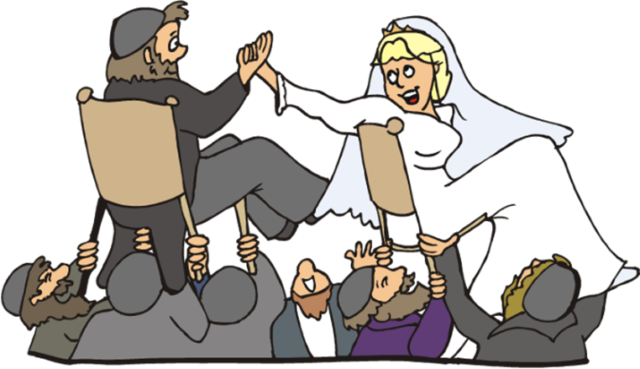
Some of our ideas include:
- Bringing in a mohel
- A mock wedding
- Dancing the Hora
- Visiting a Jewish cemetery
- Planning a school-wide Mitzvah project
- Learning what a mezinke is
- Learning to sing Siman Tov (not the version Cinnamon Toast!)
We can’t wait to get started!


